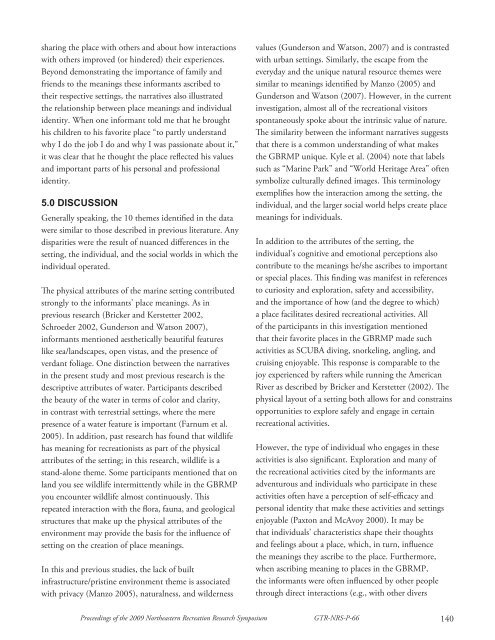Proceedings of the 2009 northeastern recreation research symposium
Proceedings of the 2009 northeastern recreation research symposium
Proceedings of the 2009 northeastern recreation research symposium
Create successful ePaper yourself
Turn your PDF publications into a flip-book with our unique Google optimized e-Paper software.
sharing <strong>the</strong> place with o<strong>the</strong>rs and about how interactions<br />
with o<strong>the</strong>rs improved (or hindered) <strong>the</strong>ir experiences.<br />
Beyond demonstrating <strong>the</strong> importance <strong>of</strong> family and<br />
friends to <strong>the</strong> meanings <strong>the</strong>se informants ascribed to<br />
<strong>the</strong>ir respective settings, <strong>the</strong> narratives also illustrated<br />
<strong>the</strong> relationship between place meanings and individual<br />
identity. When one informant told me that he brought<br />
his children to his favorite place “to partly understand<br />
why I do <strong>the</strong> job I do and why I was passionate about it,”<br />
it was clear that he thought <strong>the</strong> place refl ected his values<br />
and important parts <strong>of</strong> his personal and pr<strong>of</strong>essional<br />
identity.<br />
5.0 DISCUSSION<br />
Generally speaking, <strong>the</strong> 10 <strong>the</strong>mes identifi ed in <strong>the</strong> data<br />
were similar to those described in previous literature. Any<br />
disparities were <strong>the</strong> result <strong>of</strong> nuanced diff erences in <strong>the</strong><br />
setting, <strong>the</strong> individual, and <strong>the</strong> social worlds in which <strong>the</strong><br />
individual operated.<br />
Th e physical attributes <strong>of</strong> <strong>the</strong> marine setting contributed<br />
strongly to <strong>the</strong> informants’ place meanings. As in<br />
previous <strong>research</strong> (Bricker and Kerstetter 2002,<br />
Schroeder 2002, Gunderson and Watson 2007),<br />
informants mentioned aes<strong>the</strong>tically beautiful features<br />
like sea/landscapes, open vistas, and <strong>the</strong> presence <strong>of</strong><br />
verdant foliage. One distinction between <strong>the</strong> narratives<br />
in <strong>the</strong> present study and most previous <strong>research</strong> is <strong>the</strong><br />
descriptive attributes <strong>of</strong> water. Participants described<br />
<strong>the</strong> beauty <strong>of</strong> <strong>the</strong> water in terms <strong>of</strong> color and clarity,<br />
in contrast with terrestrial settings, where <strong>the</strong> mere<br />
presence <strong>of</strong> a water feature is important (Farnum et al.<br />
2005). In addition, past <strong>research</strong> has found that wildlife<br />
has meaning for <strong>recreation</strong>ists as part <strong>of</strong> <strong>the</strong> physical<br />
attributes <strong>of</strong> <strong>the</strong> setting; in this <strong>research</strong>, wildlife is a<br />
stand-alone <strong>the</strong>me. Some participants mentioned that on<br />
land you see wildlife intermittently while in <strong>the</strong> GBRMP<br />
you encounter wildlife almost continuously. Th is<br />
repeated interaction with <strong>the</strong> fl ora, fauna, and geological<br />
structures that make up <strong>the</strong> physical attributes <strong>of</strong> <strong>the</strong><br />
environment may provide <strong>the</strong> basis for <strong>the</strong> infl uence <strong>of</strong><br />
setting on <strong>the</strong> creation <strong>of</strong> place meanings.<br />
In this and previous studies, <strong>the</strong> lack <strong>of</strong> built<br />
infrastructure/pristine environment <strong>the</strong>me is associated<br />
with privacy (Manzo 2005), naturalness, and wilderness<br />
values (Gunderson and Watson, 2007) and is contrasted<br />
with urban settings. Similarly, <strong>the</strong> escape from <strong>the</strong><br />
everyday and <strong>the</strong> unique natural resource <strong>the</strong>mes were<br />
similar to meanings identifi ed by Manzo (2005) and<br />
Gunderson and Watson (2007). However, in <strong>the</strong> current<br />
investigation, almost all <strong>of</strong> <strong>the</strong> <strong>recreation</strong>al visitors<br />
spontaneously spoke about <strong>the</strong> intrinsic value <strong>of</strong> nature.<br />
Th e similarity between <strong>the</strong> informant narratives suggests<br />
that <strong>the</strong>re is a common understanding <strong>of</strong> what makes<br />
<strong>the</strong> GBRMP unique. Kyle et al. (2004) note that labels<br />
such as “Marine Park” and “World Heritage Area” <strong>of</strong>ten<br />
symbolize culturally defi ned images. Th is terminology<br />
exemplifi es how <strong>the</strong> interaction among <strong>the</strong> setting, <strong>the</strong><br />
individual, and <strong>the</strong> larger social world helps create place<br />
meanings for individuals.<br />
In addition to <strong>the</strong> attributes <strong>of</strong> <strong>the</strong> setting, <strong>the</strong><br />
individual’s cognitive and emotional perceptions also<br />
contribute to <strong>the</strong> meanings he/she ascribes to important<br />
or special places. Th is fi nding was manifest in references<br />
to curiosity and exploration, safety and accessibility,<br />
and <strong>the</strong> importance <strong>of</strong> how (and <strong>the</strong> degree to which)<br />
a place facilitates desired <strong>recreation</strong>al activities. All<br />
<strong>of</strong> <strong>the</strong> participants in this investigation mentioned<br />
that <strong>the</strong>ir favorite places in <strong>the</strong> GBRMP made such<br />
activities as SCUBA diving, snorkeling, angling, and<br />
cruising enjoyable. Th is response is comparable to <strong>the</strong><br />
joy experienced by rafters while running <strong>the</strong> American<br />
River as described by Bricker and Kerstetter (2002). Th e<br />
physical layout <strong>of</strong> a setting both allows for and constrains<br />
opportunities to explore safely and engage in certain<br />
<strong>recreation</strong>al activities.<br />
However, <strong>the</strong> type <strong>of</strong> individual who engages in <strong>the</strong>se<br />
activities is also signifi cant. Exploration and many <strong>of</strong><br />
<strong>the</strong> <strong>recreation</strong>al activities cited by <strong>the</strong> informants are<br />
adventurous and individuals who participate in <strong>the</strong>se<br />
activities <strong>of</strong>ten have a perception <strong>of</strong> self-effi cacy and<br />
personal identity that make <strong>the</strong>se activities and settings<br />
enjoyable (Paxton and McAvoy 2000). It may be<br />
that individuals’ characteristics shape <strong>the</strong>ir thoughts<br />
and feelings about a place, which, in turn, infl uence<br />
<strong>the</strong> meanings <strong>the</strong>y ascribe to <strong>the</strong> place. Fur<strong>the</strong>rmore,<br />
when ascribing meaning to places in <strong>the</strong> GBRMP,<br />
<strong>the</strong> informants were <strong>of</strong>ten infl uenced by o<strong>the</strong>r people<br />
through direct interactions (e.g., with o<strong>the</strong>r divers<br />
<strong>Proceedings</strong> <strong>of</strong> <strong>the</strong> <strong>2009</strong> Nor<strong>the</strong>astern Recreation Research Symposium GTR-NRS-P-66<br />
140
















